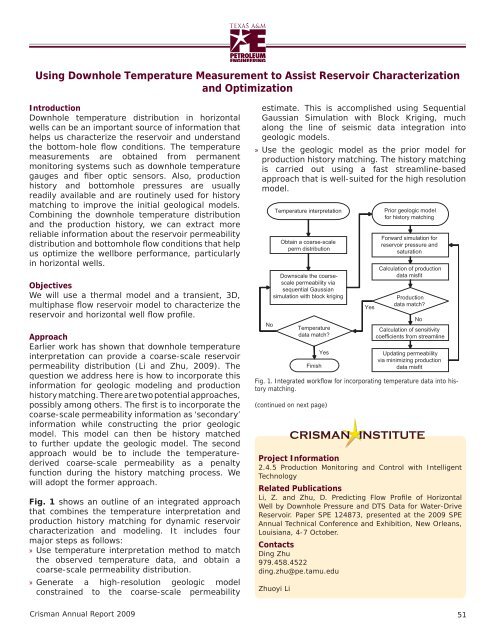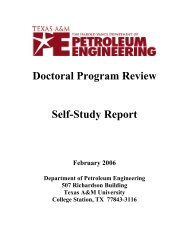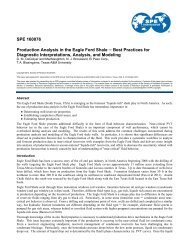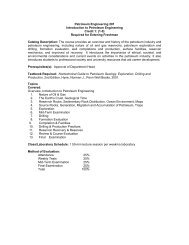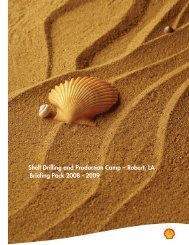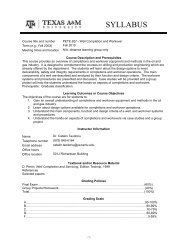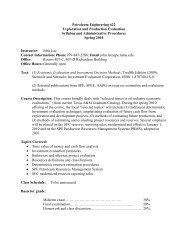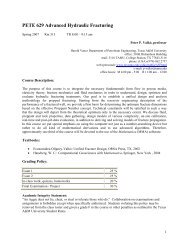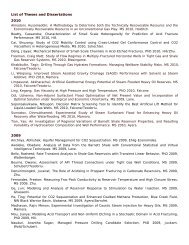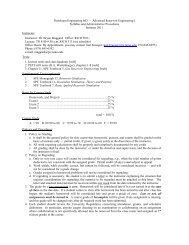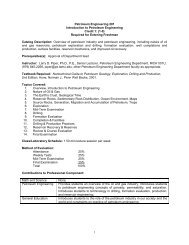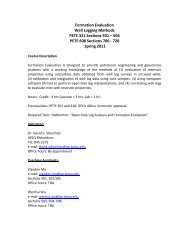Crisman Annual Report 2009 - Harold Vance Department of ...
Crisman Annual Report 2009 - Harold Vance Department of ...
Crisman Annual Report 2009 - Harold Vance Department of ...
You also want an ePaper? Increase the reach of your titles
YUMPU automatically turns print PDFs into web optimized ePapers that Google loves.
Using Downhole Temperature Measurement to Assist Reservoir Characterization<br />
and Optimization<br />
Introduction<br />
Downhole temperature distribution in horizontal<br />
wells can be an important source <strong>of</strong> information that<br />
helps us characterize the reservoir and understand<br />
the bottom-hole flow conditions. The temperature<br />
measurements are obtained from permanent<br />
monitoring systems such as downhole temperature<br />
gauges and fiber optic sensors. Also, production<br />
history and bottomhole pressures are usually<br />
readily available and are routinely used for history<br />
matching to improve the initial geological models.<br />
Combining the downhole temperature distribution<br />
and the production history, we can extract more<br />
reliable information about the reservoir permeability<br />
distribution and bottomhole flow conditions that help<br />
us optimize the wellbore performance, particularly<br />
in horizontal wells.<br />
Objectives<br />
We will use a thermal model and a transient, 3D,<br />
multiphase flow reservoir model to characterize the<br />
reservoir and horizontal well flow pr<strong>of</strong>ile.<br />
Approach<br />
Earlier work has shown that downhole temperature<br />
interpretation can provide a coarse-scale reservoir<br />
permeability distribution (Li and Zhu, <strong>2009</strong>). The<br />
question we address here is how to incorporate this<br />
information for geologic modeling and production<br />
history matching. There are two potential approaches,<br />
possibly among others. The first is to incorporate the<br />
coarse-scale permeability information as ‘secondary’<br />
information while constructing the prior geologic<br />
model. This model can then be history matched<br />
to further update the geologic model. The second<br />
approach would be to include the temperaturederived<br />
coarse-scale permeability as a penalty<br />
function during the history matching process. We<br />
will adopt the former approach.<br />
Fig. 1 shows an outline <strong>of</strong> an integrated approach<br />
that combines the temperature interpretation and<br />
production history matching for dynamic reservoir<br />
characterization and modeling. It includes four<br />
major steps as follows:<br />
» Use temperature interpretation method to match<br />
the observed temperature data, and obtain a<br />
coarse-scale permeability distribution.<br />
» Generate a high-resolution geologic model<br />
constrained to the coarse-scale permeability<br />
estimate. This is accomplished using Sequential<br />
Gaussian Simulation with Block Kriging, much<br />
along the line <strong>of</strong> seismic data integration into<br />
geologic models.<br />
» Use the geologic model as the prior model for<br />
production history matching. The history matching<br />
is carried out using a fast streamline-based<br />
approach that is well-suited for the high resolution<br />
model.<br />
No<br />
Project Information<br />
2.4.5 Production Monitoring and Control with Intelligent<br />
Technology<br />
Related Publications<br />
Li, Z. and Zhu, D. Predicting Flow Pr<strong>of</strong>ile <strong>of</strong> Horizontal<br />
Well by Downhole Pressure and DTS Data for Water-Drive<br />
Reservoir. Paper SPE 124873, presented at the <strong>2009</strong> SPE<br />
<strong>Annual</strong> Technical Conference and Exhibition, New Orleans,<br />
Louisiana, 4-7 October.<br />
Contacts<br />
Ding Zhu<br />
979.458.4522<br />
ding.zhu@pe.tamu.edu<br />
Zhuoyi Li<br />
Temperature interpretation<br />
Obtain a coarse-scale<br />
perm distribution<br />
Downscale the coarsescale<br />
permeability via<br />
sequential Gaussian<br />
simulation with block kriging<br />
Temperature<br />
data match?<br />
Finish<br />
Yes<br />
Yes<br />
Prior geologic model<br />
for history matching<br />
Forward simulation for<br />
reservoir pressure and<br />
saturation<br />
Calculation <strong>of</strong> production<br />
data misfit<br />
Production<br />
data match?<br />
No<br />
Calculation <strong>of</strong> sensitivity<br />
coefficients from streamline<br />
Updating permeability<br />
via minimizing production<br />
data misfit<br />
Fig. 1. Integrated workflow for incorporating temperature data into history<br />
matching.<br />
(continued on next page)<br />
CRISMAN INSTITUTE<br />
<strong>Crisman</strong> <strong>Annual</strong> <strong>Report</strong> <strong>2009</strong><br />
51


